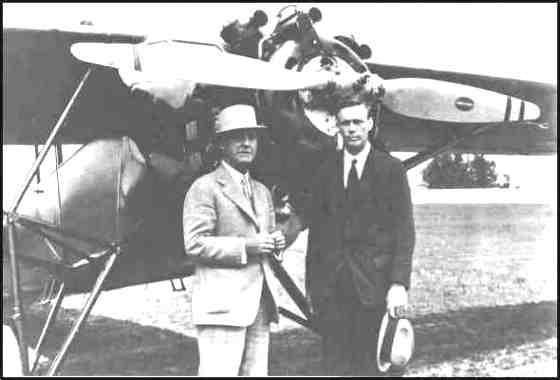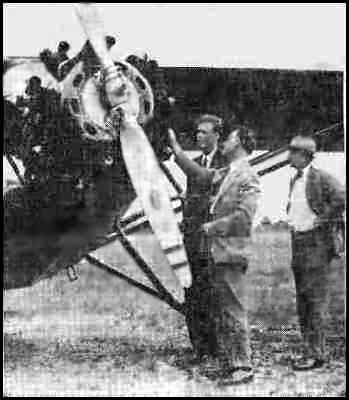|

|
| Packard President Alvin Macauley and Charles Lindbergh-(The track can be seen in the background.) |
THE DETROIT NEWS, FRIDAY, AUGUST 16, 1929
Lindy Flies With New Motor
---Drives Car at 100-Mile Clip
New experiences, both in the air and on the ground, have come to Col. Charles A. Lindbergh on his present visit to Detroit,
his first since his marriage.
For the first time in his career of flying, he piloted a plane powered by the new Diesel type oil-burning motor.
Then, to top off a busy day, he drove a high-powered automobile at a speed of more than 100 miles an hour around a banked,
concrete track.
Col. Lindbergh, in company with Maj. Thomas G. Lanphier, was invited by Alvan Macauley, president of the Packard
Motor Car Co., to inspect the new Diesel type airplane motor designed by Capt. L. M. Woolson, of the company.
LINDY AT CONTROLS
Thursday morning the fliers visited the new factory the company has built for the production of the motors, then went
to the company's proving ground near Utica, Mich., for a test flight in a plane powered by the new engine.
Col. Lindbergh was at the controls at the take-off and also when the plane landed. With him on the flight were Maj.
Lanphier, Walter E. Lees, company pilot, and Capt. Woolson. The flight lasted between 30 and 45 minutes during which the plane
motor was throttled down speeded up and otherwise put through its flying paces.
Company representatives said Col. Lindbergh and Maj. Lanphier are the first persons outside the company to be permitted
a close inspection of the new motor.
Following the flight, Co. Lindbergh and Mr. Macauley made a fuel test which demonstrated the slight chance of an
explosion or fire in the event a plane, powered with a Diesel motor fueled with fuel oil, crashed.
TEST OUT FUEL
The colonel and the company head tried to set fire to a pan of the fuel with matches, but were unsuccessful. They then
soaked a bit of waste with the oil and placed it in the pan. The waste acted as a wick and the oil burned. Col. Lindbergh
then threw oil on the flame and the flame was smothered.
Col. Lindbergh then demonstrated he is as much at home behind the wheel of an automobile as he is at the controls
of a plane. Driving a special speedster, with Charles Vincent, proving ground superintendent, as his companion, Col. Lindbergh
made six laps around the 2 1/2 mile concrete track at the proving ground.
At the conclusion of the drive he was told he had been clocked at 112 miles per hour on the straightaway and 106
miles an hour for the lap.

This page courtesy of Ralph & Jo Lees Cooper-Excerpts from the book "Pioneer Pilot" edited by Jo Lees Cooper
and their website by Ralph Cooper.
Pioneer Pilot-Walter E. Lees
|

